Constantinos Psomas
Department of Electrical and Computer Engineering, University of Cyprus
Outage Probability Analysis of Tunable Liquid Lens-assisted VLC Systems
May 20, 2025Abstract:This paper presents a tunable liquid lens (TLL)-assisted indoor mobile visible light communication system. To mitigate performance degradation caused by user mobility and random receiver orientation, an electrowetting cuboid TLL is used at the receiver. By dynamically controlling the orientation angle of the liquid surface through voltage adjustments, signal reception and overall system performance are enhanced. An accurate mathematical framework is developed to model channel gains, and two lens optimization strategies, namely ($i$) the best signal reception (BSR), and ($ii$) the vertically upward lens orientation (VULO) are introduced for improved performance. Closed form expressions for the outage probability are derived for each scheme for practical mobility and receiver orientation conditions. Numerical results demonstrate that the proposed TLL and lens adjustment strategies significantly reduce the outage probability compared to fixed lens and no lens receivers across various mobility and orientation conditions. Specifically, the outage probability is improved from $1\times 10^{-1}$ to $3\times 10^{-3}$ at a transmit power of $12$ dBW under a $8^{\circ}$ polar angle variation in random receiver orientation using the BSR scheme.
An RIS-enabled Time Reversal Scheme for Multipath Near-Field Channels
Aug 26, 2024Abstract:Time reversal (TR) is a promising technique that exploits multipaths for achieving energy focusing in high-frequency wideband communications. In this letter, we focus on a TR scheme facilitated by a reconfigurable intelligent surface (RIS) which, due to the higher frequency and large array aperture, operates in the near-field region. The proposed scheme enriches the propagation environment for the TR in such weak scattering conditions and does not need channel knowledge for the RIS configuration. Specifically, the RIS is employed to create multiple virtual propagation paths that are required to efficiently apply the TR. We derive a performance bound for the proposed scheme under near-field modeling through the received signal-to-noise ratio (SNR) and we examine how various system design parameters affect the performance. We observe that a linear RIS topology maximizes the number of resolvable paths. It is also demonstrated that the proposed scheme improves the SNR, while for a large number of elements it can outperform the conventional passive beamforming at the RIS.
DCSK-based Waveform Design for Self-sustainable RIS-aided Noncoherent SWIPT
Aug 23, 2024Abstract:This paper investigates the problem of transmit waveform design in the context of a chaotic signal-based self-sustainable reconfigurable intelligent surface (RIS)-aided system for simultaneous wireless information and power transfer (SWIPT). Specifically, we propose a differential chaos shift keying (DCSK)-based RIS-aided point-to-point set-up, where the RIS is partitioned into two non-overlapping surfaces. The elements of the first sub-surface perform energy harvesting (EH), which in turn, provide the required power to the other sub-surface operating in the information transfer (IT) mode. In this framework, by considering a generalized frequency-selective Nakagami-m fading scenario as well as the nonlinearities of the EH process, we derive closed-form analytical expressions for both the bit error rate (BER) at the receiver and the harvested power at the RIS. Our analysis demonstrates, that both these performance metrics depend on the parameters of the wireless channel, the transmit waveform design, and the number of reflecting elements at the RIS, which switch between the IT and EH modes, depending on the application requirements. Moreover, we show that, having more reflecting elements in the IT mode is not always beneficial and also, for a given acceptable BER, we derive a lower bound on the number of RIS elements that need to be operated in the EH mode. Furthermore, for a fixed RIS configuration, we investigate a trade-off between the achievable BER and the harvested power at the RIS and accordingly, we propose appropriate transmit waveform designs. Finally, our numerical results illustrate the importance of our intelligent DCSK-based waveform design on the considered framework.
Wireless Information and Energy Transfer in the Era of 6G Communications
Apr 29, 2024
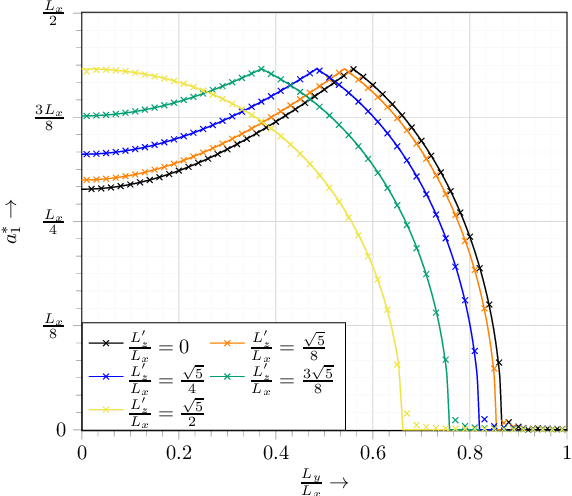
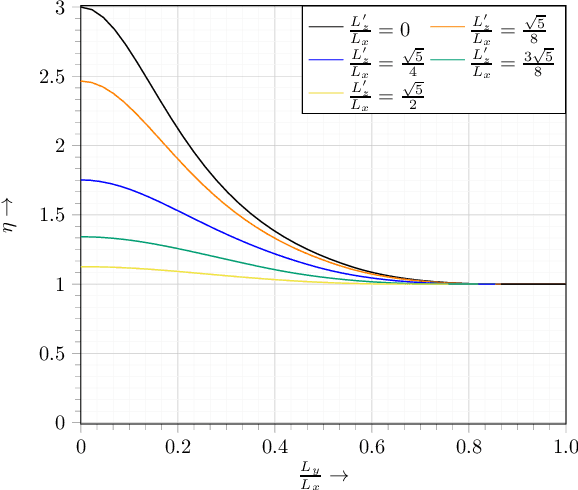

Abstract:Wireless information and energy transfer (WIET) represents an emerging paradigm which employs controllable transmission of radio-frequency signals for the dual purpose of data communication and wireless charging. As such, WIET is widely regarded as an enabler of envisioned 6G use cases that rely on energy-sustainable Internet-of-Things (IoT) networks, such as smart cities and smart grids. Meeting the quality-of-service demands of WIET, in terms of both data transfer and power delivery, requires effective co-design of the information and energy signals. In this article, we present the main principles and design aspects of WIET, focusing on its integration in 6G networks. First, we discuss how conventional communication notions such as resource allocation and waveform design need to be revisited in the context of WIET. Next, we consider various candidate 6G technologies that can boost WIET efficiency, namely, holographic multiple-input multiple-output, near-field beamforming, terahertz communication, intelligent reflecting surfaces (IRSs), and reconfigurable (fluid) antenna arrays. We introduce respective WIET design methods, analyze the promising performance gains of these WIET systems, and discuss challenges, open issues, and future research directions. Finally, a near-field energy beamforming scheme and a power-based IRS beamforming algorithm are experimentally validated using a wireless energy transfer testbed. The vision of WIET in communication systems has been gaining momentum in recent years, with constant progress with respect to theoretical but also practical aspects. The comprehensive overview of the state of the art of WIET presented in this paper highlights the potentials of WIET systems as well as their overall benefits in 6G networks.
Integrated SWIPT Receiver with Memory Effects: Circuit Analysis and Information Detection
Mar 11, 2024Abstract:Wireless power transfer has been proposed as a key technology for the foreseen machine type networks. A main challenge in the research community lies in acquiring a simple yet accurate model to capture the energy harvesting performance. In this work, we focus on a half-wave rectifier and based on circuit analysis we provide the actual output of the circuit which accounts for the memory introduced by the capacitor. The provided expressions are also validated through circuit simulations on ADS. Then, the half-wave rectifier is used as an integrated simultaneous wireless information and power transfer receiver where the circuit's output is used for decoding information based on amplitude modulation. We investigate the bit error rate performance based on two detection schemes: (i) symbol-by-symbol maximum likelihood (ML); and (ii) ML sequence detection (MLSD). We show that the symbol period is critical due to the intersymbol interference induced by circuit. Our results reveal that MLSD is necessary towards improving the error probability and achieving higher data rates.
Superimposed Chirp Waveforms for SWIPT with Diplexer-based Integrated Receivers
Nov 08, 2023



Abstract:In this paper, we present the superposition of chirp waveforms for simultaneous wireless information and power transfer (SWIPT) applications. Exploiting the chirp waveform characteristics enables us to superimpose multiple chirps, thereby allowing transmission of the same number of waveforms over less bandwidth. This enables us to perform subband selection when operating over set of orthogonal subbands. Furthermore, we consider a user equipped with a diplexer-based integrated receiver (DIR), which enables to extract radio frequency power and decode information from the same signal without splitting. Thereby, incorporating chirp superposition and subband selection, a transmission scheme is proposed to exploit both the diode's nonlinearity and frequency diversity. We derive novel closed-form analytical expressions of the average harvested energy (HE) via transmission of superimposed chirp over selected subbands based on tools from order statistics. We also analyze the downlink information rate achieved at the user. Through our analytical and numerical results, for the considered system setup, we show that superimposed chirp-based SWIPT provides an improvement of 30$\%$ in average HE performance as compared to multisine waveforms consisting of a set of fixed-frequency cosine signals, improves the minimum level of HE in a multiuser network, and extends the operating range of energy transfer as compared to fixed-frequency waveforms. Furthermore, we illustrate that the inclusion of DIR at the receiver for SWIPT enlarges the energy-information transfer region when compared to the widely considered power splitting receiver.
Continuous Fluid Antenna Systems: Modeling and Analysis
Nov 02, 2023



Abstract:Fluid antennas (FAs) is a promising technology for introducing flexibility and reconfigurability in wireless networks. Recent research efforts have highlighted the potential gains that can be achieved in comparison to conventional antennas. These works assume that the FA has a discrete number of positions that the liquid can take. However, from a practical standpoint, the liquid moves in a continuous fashion to any point inside the FA. In this paper, we focus on a continuous FA system (CFAS) and present a general framework for its design and analytical evaluation. In particular, we derive closed-form analytical expressions for the level crossing rate (LCR) and the average fade duration of the continuous signal-to-interference ratio (SIR) process over the FA's length. Then, by leveraging the LCR expression, we characterize the system's outage performance with a bound on the cumulative distribution function of the SIR's supremum. Our results confirm that the CFAS outperforms its discrete counterpart and thus provides the performance limits of FA-based systems.
Spatial Modulation with Energy Detection: Diversity Analysis and Experimental Evaluation
Sep 08, 2023
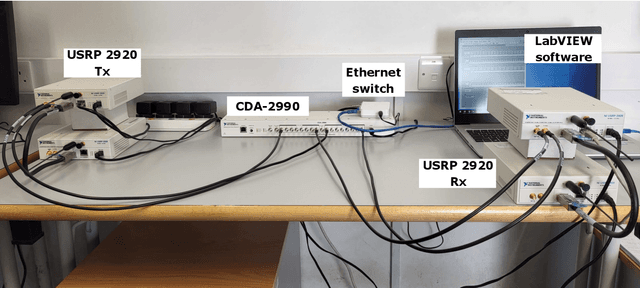
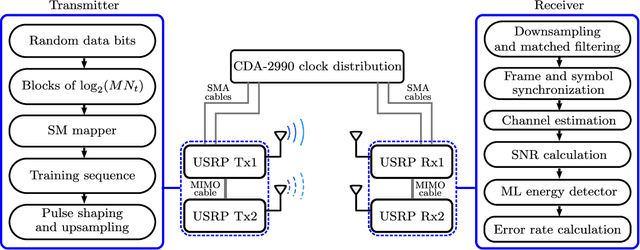
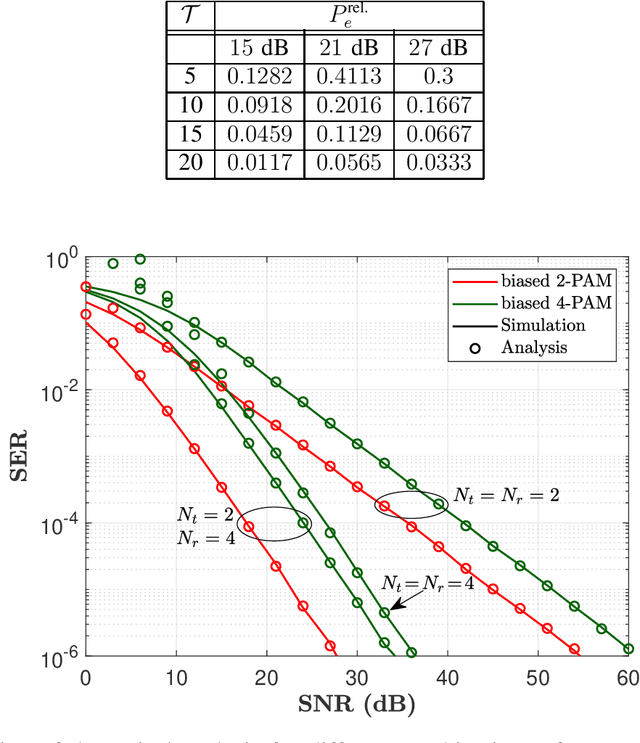
Abstract:In this paper, we present a non-coherent energy detection scheme for spatial modulation (SM) systems. In particular, the use of SM is motivated by its low-complexity implementation in comparison to multiple-input multiple-output (MIMO) systems, achieved through the activation of a single antenna during transmission. Moreover, energy detection-based communications restrict the channel state information to the magnitude of the fading gains. This consideration makes the design applicable for low-cost low-powered devices since phase estimation and its associated circuitry are avoided. We derive an energy detection metric for a multi-antenna receiver based on the maximum-likelihood (ML) criterion. By considering a biased pulse amplitude modulation, we develop an analytical framework for the SM symbol error rate at high signal-to-noise ratios. Numerical results show that the diversity order is proportional to half the number of receive antennas; this result stems from having partial receiver channel knowledge. In addition, we compare the performance of the proposed scheme with that of the coherent ML receiver and show that the SM energy detector outperforms its coherent counterpart in certain scenarios, particularly when utilizing non-negative constellations. Ultimately, we implement an SM testbed using software-defined radio devices and provide experimental error rate measurements that validate our theoretical contribution.
Chaotic Waveform-based Signal Design for Noncoherent SWIPT Receivers
Aug 25, 2023Abstract:This paper proposes a chaotic waveform-based multi-antenna receiver design for simultaneous wireless information and power transfer (SWIPT). Particularly, we present a differential chaos shift keying (DCSK)-based SWIPT multiantenna receiver architecture, where each antenna switches between information transfer (IT) and energy harvesting (EH) modes depending on the receiver's requirements. We take into account a generalized frequency-selective Nakagami-m fading model as well as the nonlinearities of the EH process to derive closed-form analytical expressions for the associated bit error rate (BER) and the harvested direct current (DC), respectively. We show that, both depend on the parameters of the transmitted waveform and the number of receiver antennas being utilized in the IT and EH mode. We investigate a trade-off in terms of the BER and energy transfer by introducing a novel achievable `success rate - harvested energy' region. Moreover, we demonstrate that energy and information transfer are two conflicting tasks and hence, a single waveform cannot be simultaneously optimal for both IT and EH. Accordingly, we propose appropriate transmit waveform designs based on the application specific requirements of acceptable BER or harvested DC or both. Numerical results demonstrate the importance of chaotic waveform-based signal design and its impact on the proposed receiver architecture.
Outage and DMT Analysis of Partition-based Schemes for RIS-aided MIMO Fading Channels
May 07, 2023Abstract:In this paper, we investigate the performance of multiple-input multiple-output (MIMO) fading channels assisted by a reconfigurable intelligent surface (RIS), through the employment of partition-based RIS schemes. The proposed schemes are implemented without requiring any channel state information knowledge at the transmitter side; this characteristic makes them attractive for practical applications. In particular, the RIS elements are partitioned into sub-surfaces, which are periodically modified in an efficient way to assist the communication. Under this framework, we propose two low-complexity partition-based schemes, where each sub-surface is adjusted by following an amplitude-based or a phase-based approach. Specifically, the activate-reflect (AR) scheme activates each sub-surface consecutively, by changing the reflection amplitude of the corresponding elements. On the other hand, the flip-reflect (FR) scheme adjusts periodically the phase shift of the elements at each sub-surface. Through the sequential reconfiguration of each sub-surface, an equivalent parallel channel in the time domain is produced. We analyze the performance of each scheme in terms of outage probability and provide expressions for the achieved diversity-multiplexing tradeoff. Our results show that the asymptotic performance of the considered network under the partition-based schemes can be significantly enhanced in terms of diversity gain compared to the conventional case, where a single partition is considered. Moreover, the FR scheme always achieves the maximum multiplexing gain, while for the AR scheme this maximum gain can be achieved only under certain conditions with respect to the number of elements in each sub-surface.
* 13 pages, 9 figures
 Add to Chrome
Add to Chrome Add to Firefox
Add to Firefox Add to Edge
Add to Edge